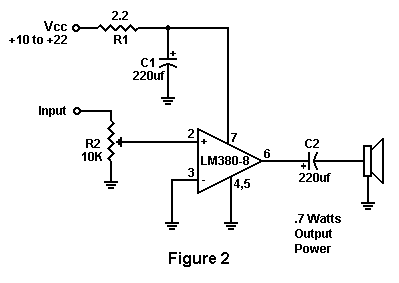
Integrated Circuit Audio
Amplifiers
By Mike Martell N1HFX
In a previous article I discussed building audio amplifiers using discrete transistors. While it is possible to build good audio amplifiers from discrete transistors, they are no match for the many audio amp IC's available to us. IC's offer many advantages including high efficiency, high gain, low standby current, low component count, small size and ,of course, low cost. It is little wonder that audio amp IC's have replaced discrete transistors in most consumer electronic devices. While many experimenters have stayed away from these little black mysteries, I am going to uncover some of their secrets and demonstrate how easy they are to use.
Our first IC amp is listed in Figure 1 and uses a LM386 IC. The LM386 comes in 3 flavors now; LM386-1, LM386-2, LM386-3 with output power levels of 300, 500 and 700 milli-watts respectively. The type sold by Radio Shack is the LM386-1 and is the one we used in this circuit. Perhaps the most unique feature is that it is available at any Radio Shack and can operate at voltages as low as 5 volts. Just like regular op amps, audio amp IC's have an inverting and non-inverting input. Input signals are normally fed to the non-inverting input while the inverting input is normally tied to ground. Because of the high gain of IC audio amps, it is highly recommended to isolate them from the power supply to prevent oscillations. In this circuit, R1 and C1 accomplish this task very well. Resistor R3 controls the gain and Capacitor C3 couples the output to the speaker. Output capacitor coupling is mandatory in just about all IC audio amp designs.
The LM386 IC is unique in that the gain can be modified by changing Resistor R2 and Capacitor C2. This configuration will give us a gain of 20. By removing R2 and connecting C2 across pins 1 and 8, we can increase the gain to 200. It is important to understand that increasing the gain does not increase the output power. The increased gain is only used when a very low input signal is to be amplified.
Our next IC is the LM380 and it also comes in two flavors; LM380-8 and LM380 with output powers of 700 milli-watts and 2 watts respectively. Figure 2 depicts the LM380-8 and Figure 3 depicts the LM380. The LM380-8 comes in an 8 pin package and its basic circuit is virtually identical to the LM380 except for the different pin out. The LM380 comes in a 14 pin package and pins 3,4,5,10,11 and 13 are connected to ground to act as a heat sink. Experience has shown the LM380 should be soldered directly to the circuit board (no IC socket) if it is going to be operated at its full rated 2 watt output. This IC can become quite warm and it's important to get rid of excess heat through the pins. The primary advantages of the LM380 series IC's are higher output power, very low distortion and low external parts count.

No matter how much volume, an audio amp provides, there are still those who require even more. The circuit in Figure 4 uses a LM383 IC amp and will provide up to 7 watts of output power for those who want to really experience their audio. The LM383 comes in a TO220 type package with 5 pins as indicated in Figure 4. My experiences with this IC revealed that it must be heat sinked at all times due to it's high standby current. If you plan to use this IC keep all components as close as possible to the IC and be certain that your power source can supply up to 1.3 amps of current. The main advantage to this IC is its 7 watt output which is why it has found its way into many inexpensive car radios. This IC offers low distortion and is a real bargain compared to discrete transistors.
It should be apparent now that audio amp IC's have much to offer us in the way of low cost audio amp circuits. There are many other audio amp IC's available to us and data sheets can be easily obtained by searching the world wide web. Almost all of the major IC manufacturers now offer their data sheets to be downloaded free at their web sites. For example, check out National Semiconductor at http://www.national.com/design/ and Motorola at http://mot-sps.com/cgi-bin/dlsrch for all kinds of information on a wide array of IC's and other solid state devices.
DE N1HFX
Parts Suppliers
JDR MicroDevices
1850 South 10th Street
San Jose, CA 95112-4108
1-800-535-5000
http://www.jdr.com
Mouser Electronics
958 North Main Street
Mansfield, TX 76063-4827
1-800-346-6873
http://www.mouser.com